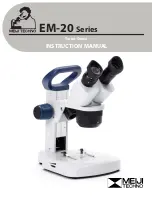
INTRODUCTION TO LASER SCANNING MICROSCOPY
LSM 510
DuoScan
Carl Zeiss
Performance Features of the LSM 510 …
LSM 510 META
DuoScan
3-6
B 45-0021 e
03/06
Selection of the specimen detail of interest for zooming is fast and convenient, and the zoomed image is
automatically centered. This saves the job of specimen centration with the microscope stage.
Using a bi-directional scanning facility will double the scanning rate to approx. 5 frames/sec (at 512
×
512
pixels); if two different laser wavelengths are used for the two scanning directions (wavelength 1 for left-
to-right, and wavelength 2 for right-to-left scanning), two fluorochrome dyes can be viewed and
documented in a quasi-simultaneous mode. This will prevent cross talk between detection channels.
The LSM 510 and LSM 510 META can be combined with a second scanner, the LSM
DuoScan
. Any of the
above mentioned microscopes can be used. The
LSM DuoScan
can be equipped either with a UV Laser or
a 405 nm laser both also together with a 488 and/or 532 nm laser. The software allows to simultaneously
image and bleach/manipulate a sample. The usefulness of this option is dependent on the sample.
3.4.2
Microscope Equipment of the LSM 510 and LSM 510 META System
The LSM 510 or LSM 510 META system is equipped either with the inverted Axiovert 200 M BP or SP
microscope or with the upright Axio Imager.Z1, Axio Imager.M1 or Axioskop 2 FS
MOT
microscopes.
Only the differences from the delivered operating manual "Axiovert 200 M" will be explained here.
(1) Stand
a)
The motorized objective nosepiece 5
×
H DIC is firmly fixed to the stand, where no operating elements
can be found for the nosepiece. Operation will be performed via LSM 5 software control. The "Restriction
of the nosepiece height to protect the objectives during motorized objective change" is inactivated. The
nosepiece will be moved down automatically before each motorized objective change.
b)
The reflector mount is motorized and provided with the Axiovert 200 M reflector turret. The reflector
turret has 5 positions: One transmitting light position, which is identical to the LSM position, and four
further positions for fluorescence filter sets (reflector modules). If you want to use more than five
conventional fluorescence filter sets, it is advisable to use a further reflector turret. When changing the
reflector turret position you must make sure that the turret will click into position, since otherwise the
image area will be cut. If the system is equipped with the LSM
DuoScan
up to three positions (depending
on the laser equipment of the LSM
DuoScan
) are equipped with fixed beam combiners. Two positions of
the reflector turrent can be equipped with conventional fluorescence filter sets.
c)
The stand has a motorized focusing drive (fine coarse). Sensitivity of the focusing drive is adjusted to
the delivered objectives by the manufacturer. If you want to use other objectives, sensitivity and
parfocality can be adjusted via the Axioset program.
d)
The stand features an integrated power supply for the internal motors and stand electronics. The
power supply can be switched on at the right side of the stand. External power supply units will be used
for the mercury vapor short arc lamp.
e)
The analyzer slider for conventional DIC methods will be operated from the right side and is located
just below the nosepiece.
When the rod is pushed in, the analyzer is located in the beam path. In the LSM-mode, the analyzer must
not
be located in the beam path, and the analyzer rod must be pulled out.
(2) Specimen stages and fine focus drives
a)
Mechanical stage
The stage with coaxial drive must be mounted on the right side of the stand.
b)
Scanning stage
c)
Piezo objective focus drive
















































